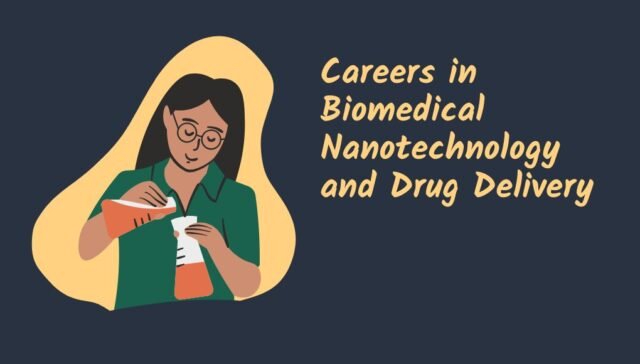Biomedical Nanotechnology and Drug Delivery
Biomedical nanotechnology is an interdisciplinary field that merges principles from nanotechnology and biomedical sciences to develop innovative solutions for healthcare challenges. A significant application of this field is in drug delivery systems, where nanoscale materials are engineered to transport therapeutic agents directly to targeted cells or tissues, enhancing treatment efficacy and minimizing side effects. As this domain evolves, it offers a plethora of career opportunities for professionals passionate about advancing medical technology.
Careers in biomedical nanotechnology,
Drug delivery research positions,
Nanomedicine job opportunities,
Nanotechnology in healthcare careers,
Advanced drug delivery jobs.
Table of Contents
- Introduction to Biomedical Nanotechnology
- Applications in Drug Delivery
- Educational Pathways
- Career Opportunities
- Top Universities Offering Relevant Courses
- Job Prospects Worldwide
- Further Reading
1. Introduction to Biomedical Nanotechnology
Biomedical nanotechnology involves the application of nanoscale materials and devices in medicine. By manipulating matter at the molecular and atomic levels, scientists can create tools and treatments with unprecedented precision. This field encompasses various areas, including diagnostics, therapeutics, and regenerative medicine.
2. Applications in Drug Delivery
One of the most promising applications of biomedical nanotechnology is in drug delivery. Traditional drug delivery methods often face challenges such as poor solubility, rapid degradation, and non-specific distribution, leading to reduced efficacy and increased side effects. Nanotechnology offers solutions to these challenges:
-
Targeted Delivery: Nanocarriers can be engineered to recognize and bind to specific cell receptors, ensuring that drugs are delivered directly to diseased cells while sparing healthy ones.
-
Controlled Release: Nanoparticles can be designed to release their payload in response to specific stimuli (e.g., pH changes, temperature), allowing for controlled and sustained drug release.
-
Improved Solubility: Encapsulating hydrophobic drugs in nanocarriers can enhance their solubility and bioavailability.
-
Reduced Toxicity: By targeting drugs more precisely, the required dosage can be reduced, minimizing potential side effects.
These advancements have significant implications for treating various diseases, including cancer, cardiovascular disorders, and neurological conditions.
3. Educational Pathways
Pursuing a career in biomedical nanotechnology and drug delivery typically requires a strong foundation in the sciences. Relevant undergraduate degrees include:
- Biomedical Engineering
- Chemical Engineering
- Materials Science
- Biochemistry
- Pharmacy
Advanced positions often necessitate graduate studies, where individuals can specialize in nanotechnology applications in medicine. Interdisciplinary programs that combine aspects of biology, chemistry, physics, and engineering are particularly beneficial.
4. Career Opportunities
The integration of nanotechnology in medicine has led to diverse career paths:
-
Research Scientist: Conduct studies to develop and test new nanomaterials and drug delivery systems.
-
Biomedical Engineer: Design and develop devices or systems that incorporate nanotechnology for medical applications.
-
Pharmaceutical Scientist: Focus on formulating and optimizing nano-based drug delivery methods.
-
Regulatory Affairs Specialist: Ensure that nanotechnology-based products comply with governmental regulations.
-
Quality Control Analyst: Monitor and test nanomedical products to maintain high standards.
-
Clinical Research Coordinator: Oversee clinical trials involving nanotechnology-based treatments.
Professionals can find opportunities in various settings, including:
- Pharmaceutical companies
- Biotechnology firms
- Academic and government research institutions
- Medical device manufacturers
- Regulatory agencies
5. Top Universities Offering Relevant Courses
Several esteemed institutions worldwide offer programs specializing in biomedical nanotechnology and drug delivery:
-
Massachusetts Institute of Technology (MIT), USA: Renowned for its cutting-edge research in nanotechnology applications in medicine.
-
University of California – Berkeley, USA: Offers interdisciplinary programs focusing on nanoscience and its biomedical applications.
-
Stanford University, USA: Provides courses that integrate nanotechnology with biomedical engineering.
-
Georgia Institute of Technology, USA: Known for its research in nanomedicine and drug delivery systems.
-
University of Oxford, UK: Offers an MSc in Nanotechnology for Medicine and Health Care, focusing on the application of nanotechnologies in clinical settings.
-
Università degli Studi di Pavia, Italy: Provides a specialized curriculum in Nanomedicine for Drug Delivery, emphasizing the design of nanomedicines.
-
Northeastern University, USA: Offers a Master of Science in Nanomedicine, focusing on research, innovation, and commercialization.
6. Job Prospects Worldwide
The demand for professionals in biomedical nanotechnology and drug delivery is on the rise globally. Here are some platforms and companies offering relevant positions:
-
Indeed: A comprehensive job search platform listing numerous positions in biomedical nanotechnology.
-
ZipRecruiter: Offers listings for biomedical nanotechnology roles across various locations.
-
Biotech Careers: Provides information on companies specializing in nanoparticles and related job opportunities.
7. Further Reading
For those interested in delving deeper into the field, consider exploring the following resources:
-
“Careers in Nanomedicine and Drug Delivery” – An article discussing various career trajectories in the field, highlighting the growing demand for experts in biomedical nanotechnology. (Link)
-
“Nanotechnology in Drug Delivery: Opportunities and Challenges” – A detailed overview of the current state of nanotechnology in drug delivery, discussing the potential and obstacles faced by researchers and industry professionals. (Link)
-
“The Future of Biomedical Nanotechnology” – An insightful analysis of emerging trends and future possibilities in biomedical nanotechnology, with a focus on innovative drug delivery systems. (Link)
-
“Nanomedicine: Principles and Practices” – A comprehensive textbook that serves as an excellent resource for students and professionals looking to build a strong foundation in nanomedicine. (Link)
8. Future Prospects and Trends
The field of biomedical nanotechnology and drug delivery is evolving rapidly, with several trends shaping its future:
-
Personalized Medicine: Advancements in nanotechnology are paving the way for personalized medicine, where treatments are tailored to individual patients’ genetic profiles. Nanoparticles can be designed to target specific molecular markers, increasing the precision of therapeutic interventions.
-
Artificial Intelligence Integration: AI and machine learning are being integrated with nanotechnology to optimize drug design, predict drug interactions, and enhance diagnostic accuracy. This synergy accelerates the drug discovery process and improves treatment outcomes.
-
Nanorobotics: The development of nanoscale robots, or nanobots, is a futuristic approach aimed at performing complex tasks within the human body, such as targeted drug delivery, tumor destruction, and tissue repair.
-
Regenerative Medicine: Nanotechnology is contributing to regenerative medicine by developing scaffolds and nanomaterials that support tissue engineering and organ regeneration. This has significant implications for treating chronic diseases and injuries.
-
Environmental and Ethical Considerations: As the field grows, there is increasing awareness of the environmental impact of nanomaterials. Researchers are exploring biodegradable and eco-friendly nanoparticles to minimize adverse effects. Ethical considerations related to nanomedicine’s long-term implications are also being actively discussed.
9. Challenges in Biomedical Nanotechnology and Drug Delivery
Despite the immense potential, the field faces several challenges:
-
Regulatory Hurdles: The regulatory landscape for nanomedicine is complex, with different countries having varying safety and efficacy standards. Gaining approval for nano-based therapeutics can be time-consuming and costly.
-
Toxicity and Safety Concerns: The long-term effects of nanoparticles on human health and the environment are not yet fully understood. Extensive research is needed to assess their biocompatibility and potential toxicity.
-
Manufacturing Scalability: Producing nanoparticles with consistent quality and at a large scale remains a challenge. Advanced manufacturing techniques and quality control measures are required to meet industry demands.
-
Public Perception and Acceptance: Public awareness and acceptance of nanomedicine are still limited. Educating the public about the benefits and safety of nanotechnology in healthcare is essential for widespread adoption.
10. Conclusion
Biomedical nanotechnology and drug delivery represent a revolutionary approach to healthcare, offering innovative solutions to complex medical challenges. With the potential to enhance treatment efficacy, reduce side effects, and enable personalized medicine, this field is at the forefront of modern healthcare innovation.
As research continues to advance, the demand for skilled professionals in this interdisciplinary domain is expected to grow. Whether you are a student exploring career options or a professional seeking to specialize in nanomedicine, numerous educational and career opportunities await you in this exciting field.
By staying informed about the latest trends, pursuing relevant educational pathways, and gaining hands-on experience through internships or research projects, you can build a successful and impactful career in biomedical nanotechnology and drug delivery.
11. Final Thoughts and Call to Action
Are you ready to embark on a career that combines cutting-edge science with the potential to transform healthcare? Explore the educational opportunities at the top universities mentioned in this article, stay updated with the latest research developments, and connect with industry professionals through conferences and online communities.
With passion, curiosity, and dedication, you can contribute to the future of medicine and make a significant difference in patients’ lives.
For more information and updates on careers in biomedical nanotechnology and drug delivery, stay connected with industry leaders and academic institutions through their websites and social media platforms.














